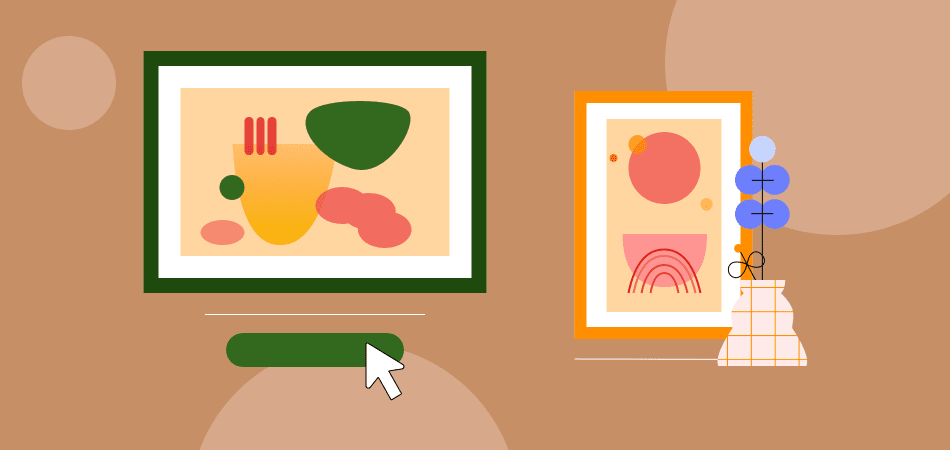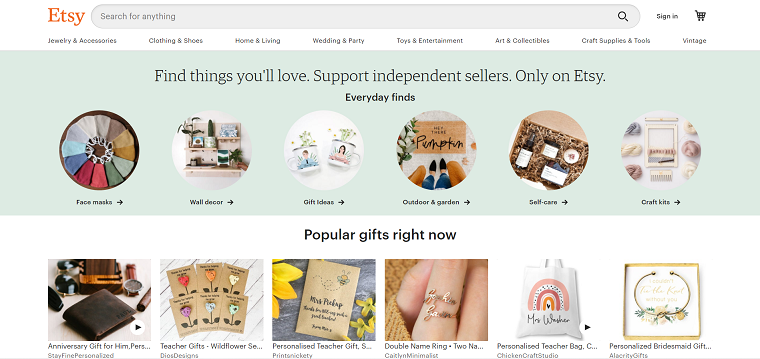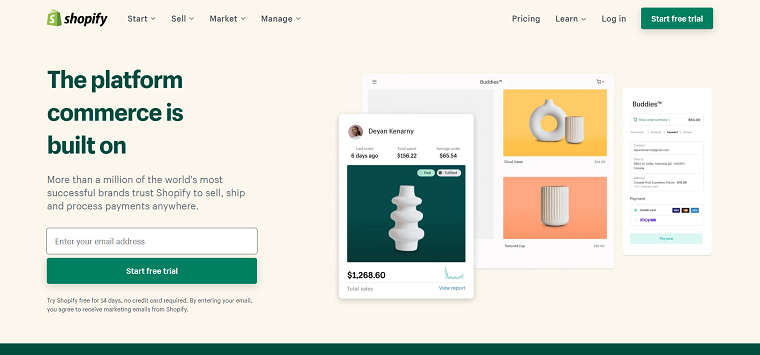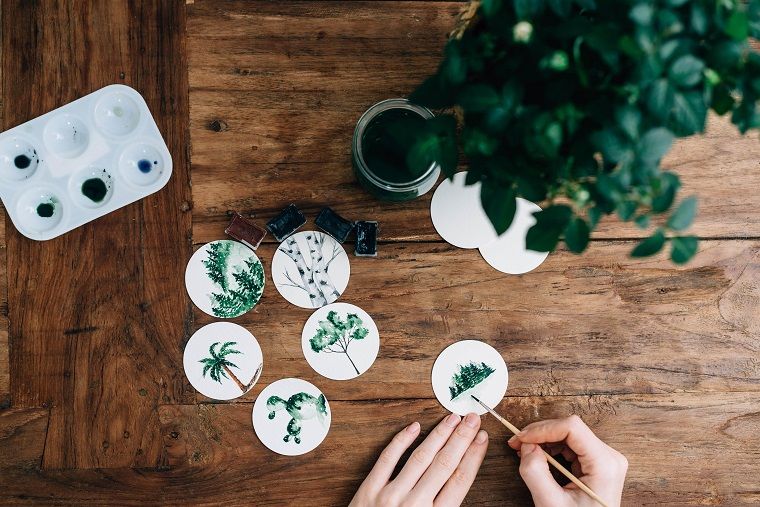How to Sell Art Online - A Goldmine Opportunity

In the past, artists were very limited in how, when, and where to sell their art. There were no special or dedicated websites that sell art. If you want to get your artwork into someone's hands, you have to find a way to reach out to them in person, whether it be at an art gallery, a creative show, or an impromptu street auction.
Thanks to the Internet, it’s easier for artists to share and sell their artwork online with art lovers around the world. Artists can auction off their pieces on popular e-Commerce platforms as well as create their own websites, for instance with this Hostinger website builder. Whether you're a creator or curator looking to make money selling art online, this guide on how to sell art online is for you.
Why Sell Art Online
The truth is, people love art products. Whether they're buying art works for home and office decoration or buying art supplies to create their own art projects, this niche isn't going away anytime soon.
In fact, in 2017 alone, the global art market grew from $57 billion to $63.7 billion. The online art market is expected to reach $9.58 billion in annual sales by 2020. The biggest art markets are the populous United States, Britain, and China. You can choose from a range of art products.
From wholesale art supplies to wall art to paintings to children's decals. There are also many subcategories in art. These include landscape, floral, cityscape, seascape, people, and so on. These subcategories allow you to cater to a wider audience.

Once you've chosen the type of art you want to sell, it's time to think about how to sell it. The most popular option is to sell art through an online store - either your own or an existing market.
You still need a website where potential customers can reach you, learn about your work, and actually buy your art, no matter how you decide to sell art online. That's why no matter which business model you choose, you need to start an online store to take the first step.
Selling Art Online: Pros and Cons
But, as with every step in your artistic career, it's important to pay attention to each step and consider whether selling art online is right for you. Here are some pros and cons of joining an online gallery.
1. Expand Your Influence
When it comes to online art sales, it means that you can meet people in other states and other countries. Plus, you can reach a completely different audience.

Online stores & marketplaces allow art to be discovered by buyers who are usually uncomfortable with the forbidding environment of galleries. Buyers can now set up a collection in the comfort of their own homes.
This is your chance to cultivate a previously untapped pool of art buyers -- good for you, and good for the art market as a whole.
2. Marketing through Multiple Channels
Promoting art online is like a one-time investment. If you have your own website to showcase art galleries, or you promote your art through social media or with the help of curators, it is cost-effective compared to traditional techniques.
Selling art on your own website requires a daily hustle. You need to advertise your latest work on social media like Facebook, Instagram, Twitter, and Pinterest. You can create a blog or maintain a newsletter to keep potential buyers interested.

You can also market your work through online art galleries by advertising on those websites. Some online art galleries have invested millions of dollars to increase traffic to their sites.
Indeed, they often represent thousands of artists, but a successful website can introduce your work to interested buyers without you having to lift a finger.
3. Supplement Your Income
Let's face it, making a living as an artist is not easy. Even some veteran artists struggle to maintain a steady income from month to month. Selling reproductions of artwork online can increase your income.
With a traditional gallery or art exhibition, you have to rent space to display art every time, and you don't even have the freedom of time, because you can only display your work during a certain period in the rented space.

Commissions for online galleries are often much lower than those for brick-and-mortar galleries. It can range from 1-5% at the low end to 10% at the high end. Websites can do this because they have lower administrative costs.
But if you're currently selling your art through galleries, make sure you don't underestimate them. It's important to have a positive relationship with the people who help you sell your art.
1. Personal Connections Missing
When you leave sales to the online store or marketplace, you won't have the opportunity to make a personal connection with the buyer. When you leave sales to the online store or marketplace, you won't have the opportunity to make a personal connection with the buyer. Your interaction with the buyer is limited, if any.
Cultivating relationships with buyers is one way to turn them into repeat customers and collectors, especially for art sales because artworks always convey a certain emotion, personal expression, and the value of the artist.
2. Fierce Competition
Many buyers want lower prices online. According to Alan Bamberger, an industry expert, the average sale price for online art is between $300 and $1,200. Sales of more than $2000 - $3000 are rare. Many online buyers don't care about authenticity.
If the artwork is something they like, shoppers are happy to buy a print of it. While a numbered canvas print might add value, it won't be as much as an original. But, over time, you can increase your price point while building a good reputation. Then you'll have a group of buyers and collectors who love your work and respect your brand.
Tips to Sell Art Online
Although running an online storefront might take up a bit of your spare time, it can be a great way to expand your reach and find a hungry audience if you have a clear mindset of marketing strategies and know what to do to increase the sales.
1. Identify Your Niche
Before you start selling artwork online, it's a good idea to find your market segment and unique style that will set your work apart from other sellers. This will deliver your strengths to potential clients and reflect who you are as an artist.

It may be time-consuming to choose widely from many art styles, but, learning from experience, you will have a higher chance of success if you narrow down your range of styles, media, or themes to create or work in a niche market.
2. Find the Right Market
A good way to sell art online is through online marketplaces that specialize in buying and selling art. Etsy is a well-known online marketplace for artisans and creatives of crafts, prints, and unique goods. You can manage Etsy lists and orders, communicate with buyers, and buy and print postage through an online dashboard.
One of Etsy's main attractions for business owners is the ability to tap into the platform's large existing customer base (there were nearly 39.45 million buyers in 2018), so you'll have less work to do in attracting customers.

It means that it's also a very saturated market, so it's hard for your listings to show up in search results, especially if you don't have previous audiences or sales to start with.
There are many things to consider when publishing art for sale in this market, and an in-depth understanding of SEO (Search Engine Optimization) and keyword research will get you started in the right direction. Even for beginners, the site has a relatively high success rate in selling art. Artists have made thousands of dollars using the platform.
3. Start Your Own Store
If you don't have your website or online art store, but do not want to participate in a third-party market, you can sell your work on your own website with nominated platforms like Shopify.

As mentioned above, it's still essential to have your own website. The design of your website should reflect your artistic style and provide a showcase for potential buyers and fans of your artwork. It should feature your best work and be a virtual representation of your brand.
4. Know the Value and How to Price
You're an artist, and you'd rather spend time in the studio. You can always pay someone else to manage your website or even social media, while no one can set the price but you. While getting started is usually the hardest part, this is just the beginning.

When pricing your art, it's important to research various ways to do this, while ensuring that you don't underestimate or overestimate your art. You might find it useful to start with a certain art pricing rule and adjust it as the business grows if you're a beginner and have never sold your work before, rather than pulling random numbers out of the air.
After your first few sales, you will have confidence in knowing if your price is right. You'll find a pricing formula that works for you, and it won't take much effort to come up with a price. Soon, you'll be raising prices.
5. Sell Legally
Selling art online means that you should know, understand and comply with the laws and legal provisions relating to the sale, trade, and purchase of art. The other side of the equation is the right to know your own intellectual property. Do you know what to do if you find someone on the Internet reselling your work as their own?
If you want to sell legally and let the copycats get punished, you need to have the knowledge related to selling art online. There are many online resources and free legal advice for artists, like A-N Insurance, an excellent site for getting information from, the Business and IP Centre at the British Library, and ArLaw.
6. Sell Art Supplies
Art supplies are always in great demand. From charcoal, watercolor paints and brushes, easels, and canvases, people have always bought these items for their careers and hobbies. When you create your own niche art store, you will be able to carve out your own profitable store from this very hot market.
Just like any other niche market, art supplies can lead to more sales if you implement the right sales strategy. If you deal with the right supplier of art products, your profit margin can be as high as you can imagine.

If you want to focus more on selling your art than on the art supplies, you may want to dropship - a distribution model that needs nothing but a computer and an Internet connection - the art supplies to spend more time working on the art itself.
Dropshipping doesn't require the rent of a warehouses for inventory. You just need to pick what art supplies to sell on your store from dropshipping sourcing platforms like AliExpress. With the right products and strategy, you can imagine the profitability of this dropshipping business model.
DSers - Dropship Art with Ease
However, if you fail to perform business operations in a timely manner, things can get trickier. The wrong product list, wrong packaging, or low-quality products can destroy your online brand. After all, no one can carry all these responsibilities on one shoulder.
| Get Started Now to Grow Your Online Business with the Best AliExpress Dropshipping Tool - DSers! |
So you need dropshipping tools like DSers to take the "busy work" part of your art sales process for you. Whether you are managing an independent online art supply store or working with a mature market, DSers can provide technology solutions to meet your needs.
The order fulfillment service of DSers can benefit your art dropshipping business through its automatic order process with only simple clicks. Also, the DSers Supplier Optimizer feature can help you find better and trustworthy suppliers on AliExpress. The best products are always the best campaign for your online store.
Final Word
It is possible to make the art you want to create and make a good income from it. The Internet allows you to sell art online directly to your fans and reach a new audience of potential buyers.
You can cut out the middlemen and become the sole distributor of your own artwork. Online art sales have great potential, and through the careful and strategic use of the Internet, the possibilities are endless.













 Company
Company
 Why Choose DSers
Why Choose DSers
 Blog
Blog
 Help Center
Help Center




 Live Chat
Live Chat